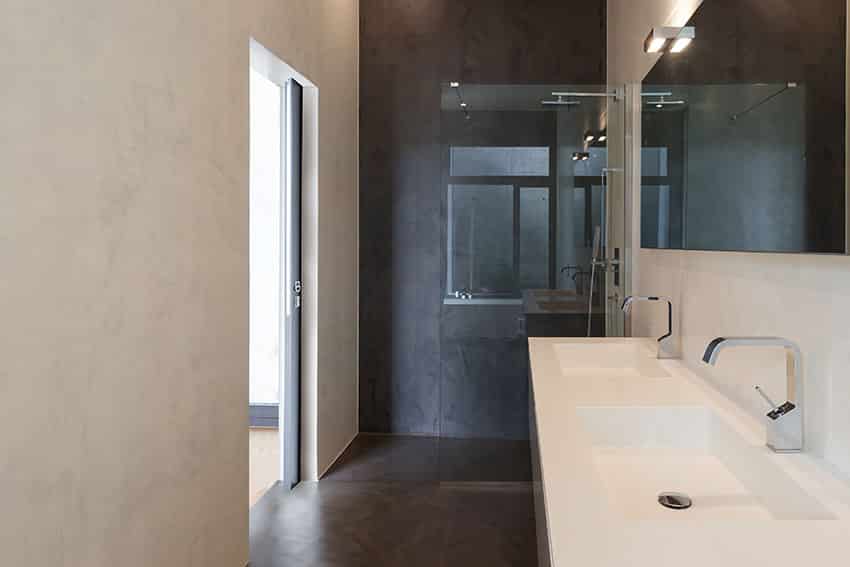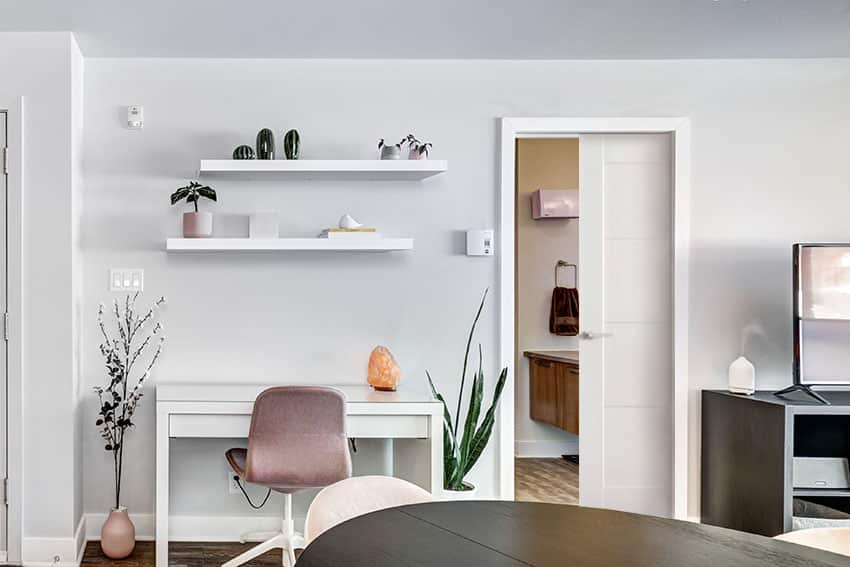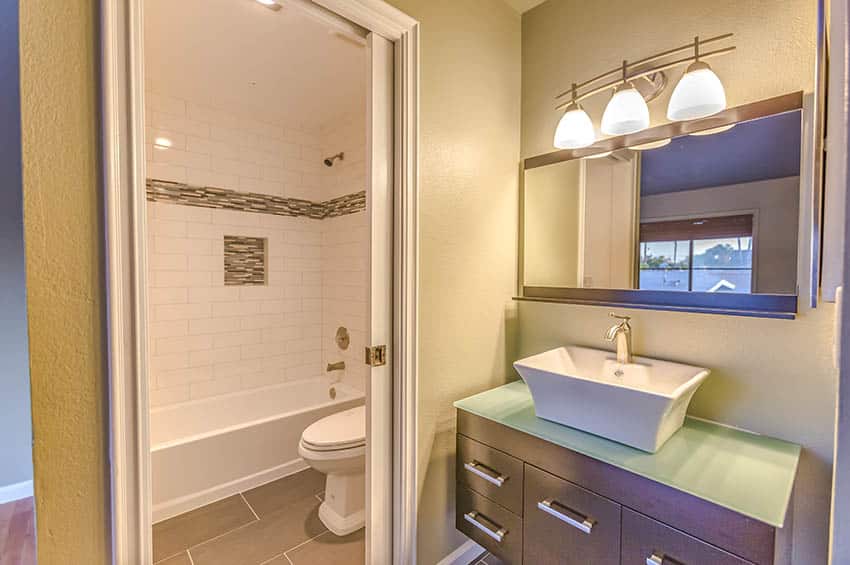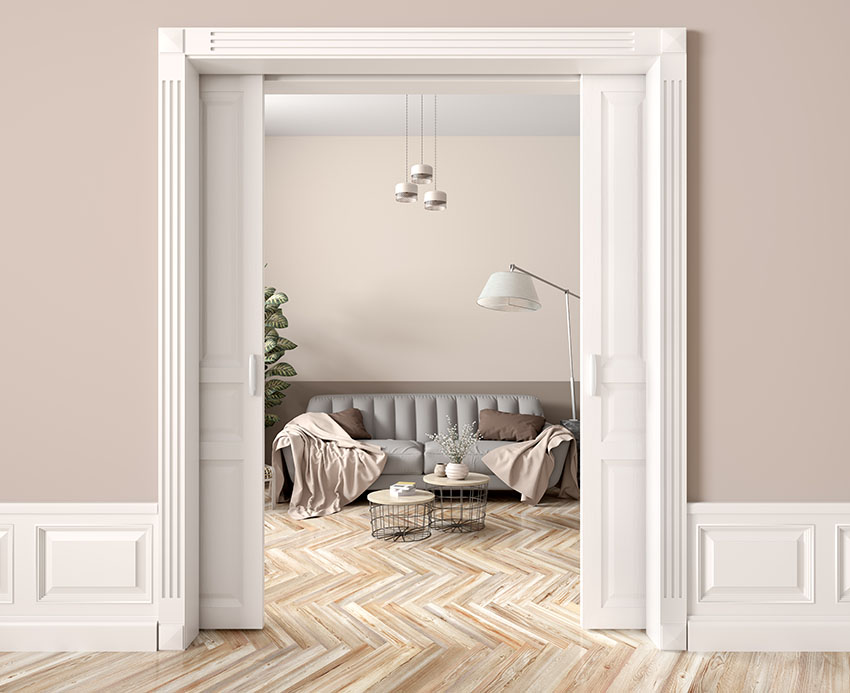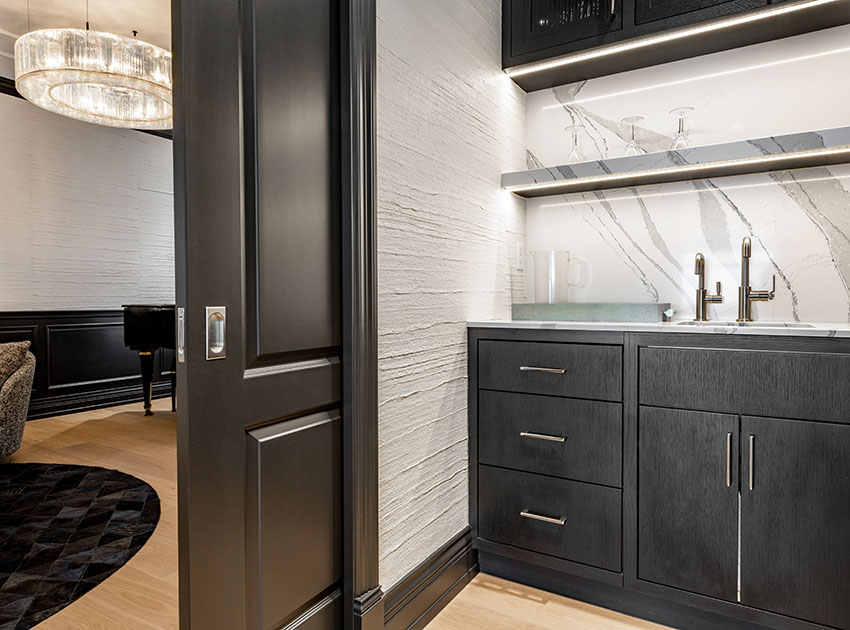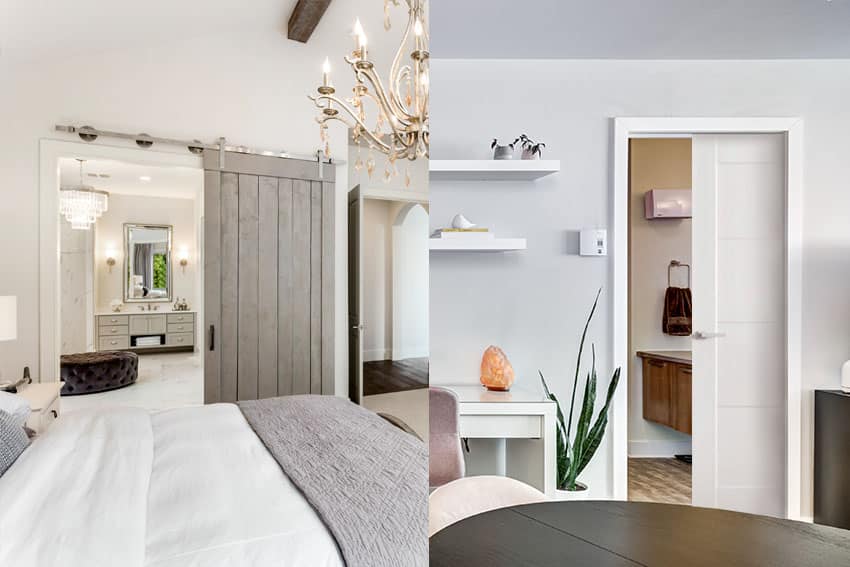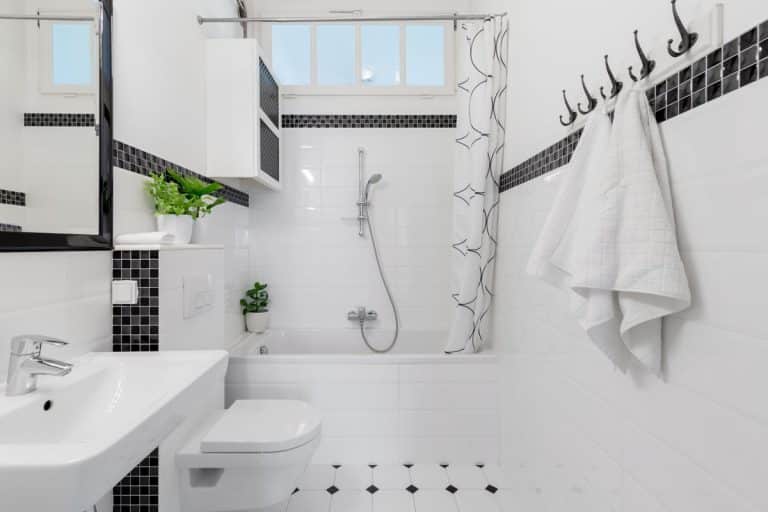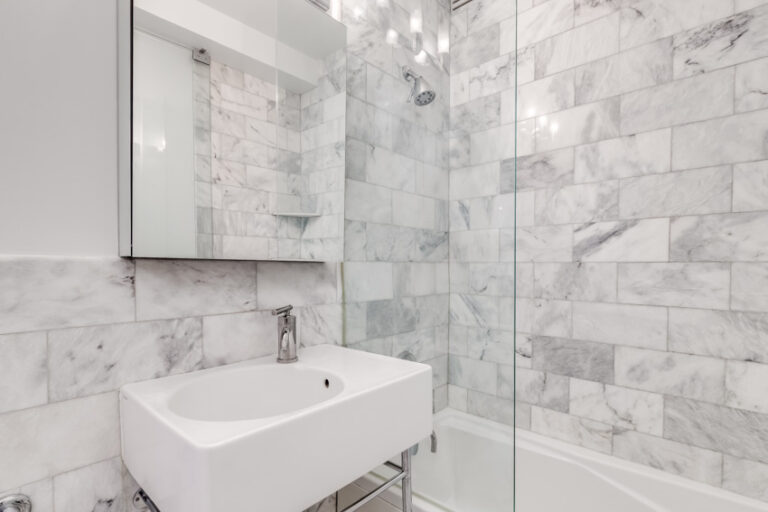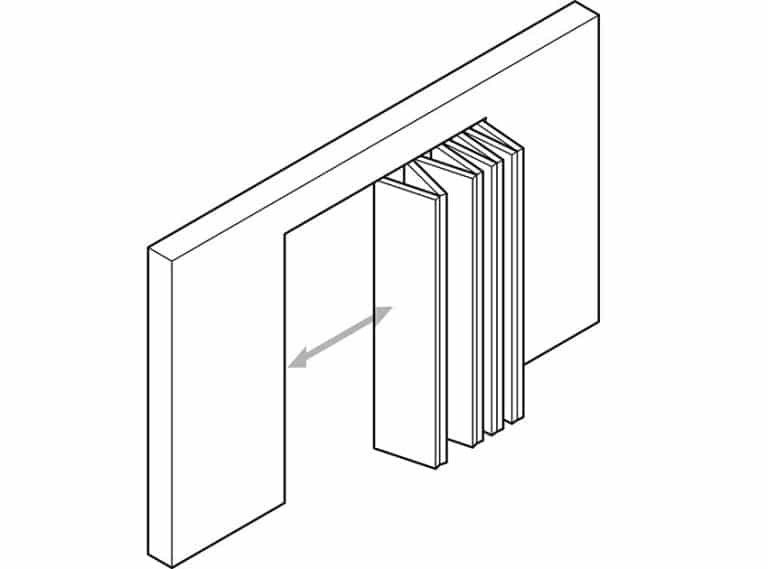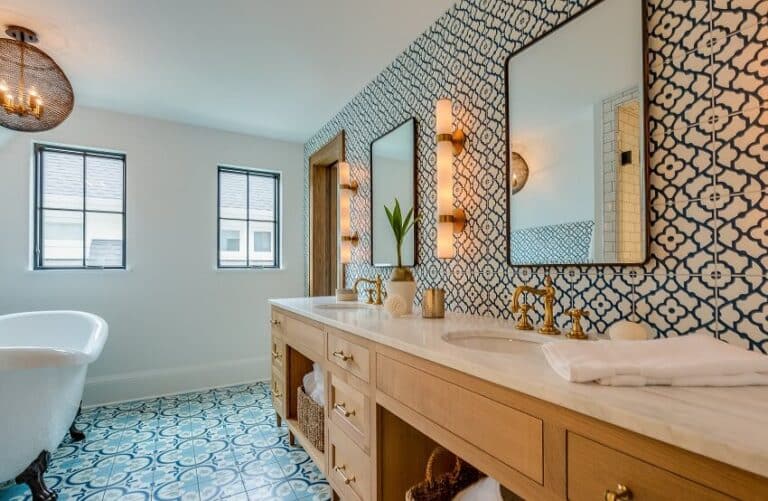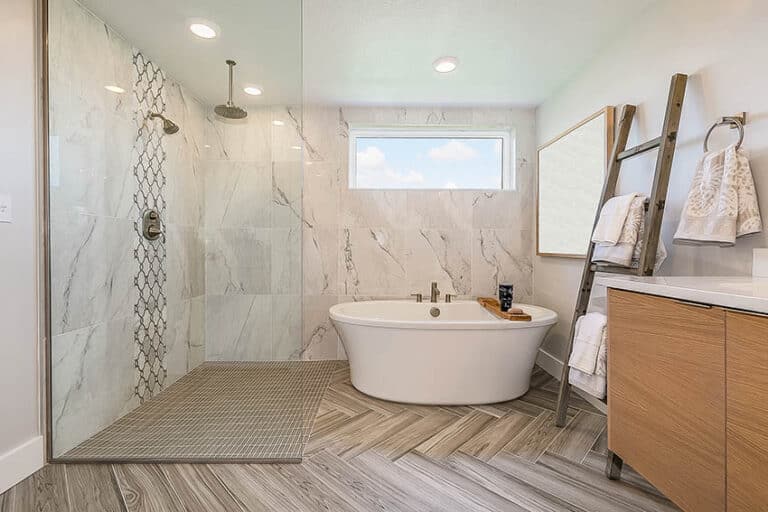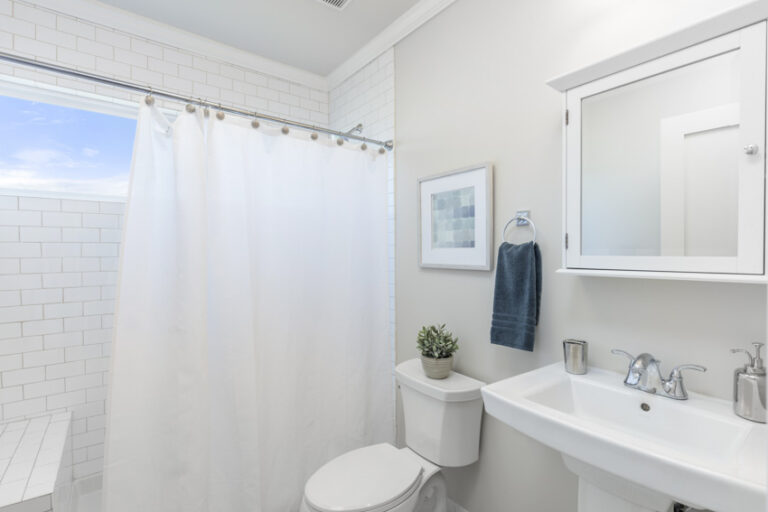Different Types of Pocket Doors For Bathrooms: Pros and Cons
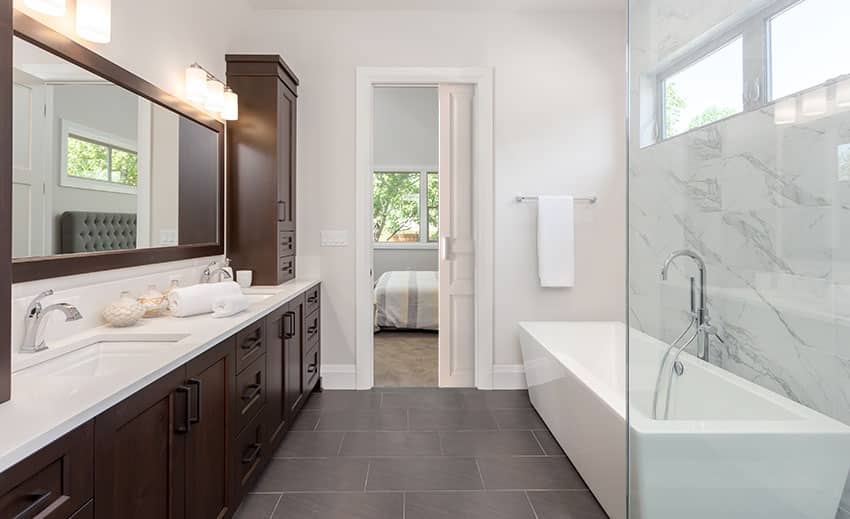
Pocket doors are popular among designers, builders, and homeowners who want to save space. We frequently see pocket doors linking a bedroom to a bathroom, and they have a very sophisticated and streamlined aesthetic to them. These doors can be used in both traditional and modern settings and, as previously said, are a significant space saver. However, what should you consider before picking this type of door? Is it true that pocket doors are great for bathrooms? Let’s see if this door style is right for your home.
What Is A Pocket Door?
Pocket doors are mounted from the ceiling and glide along a rail installed within the wall. Whenever the door is opened, it will seem like it is disappearing into the space inside the wall. Rather than swinging out from a hinge, these sliding doors are concealed inside a wall cavity.
These doors are great for spaces with limited square footage because they add 10 square feet of functional floor space that an open door would otherwise cover. Because the frame will fit inside the wall, the length of the wall will determine whether this form is functional.
Pocket doors, as the name implies, are sliding door designs that glide inconspicuously into a gap within a framing or a wall, which pertains to the pocket. This style is ideal for reducing space and producing a more streamlined appearance in a bathroom. They are also referred to as a wall slider or cavity door.
Although there may be additional considerations regarding fixtures and mechanisms, the space saved from where traditional door swings in and out could make a massive difference between one bathroom arrangement and another.
Furthermore, a pocket door links the bathroom and bedroom without requiring the space required for a regular door to swing inward or outward. Thus, you might use the extra space obtained by not having a traditional doorway for a bigger room layout.
This can translate to a larger shower, greater floor area in both the bedroom as well as the bathroom, or to allow for the potential of a better overall arrangement. These sliders are also an excellent choice for a downstairs or basement bathroom where space is limited.
It’s always nice to find a way to increase the usable space in your home without expending a great deal of effort or money. Such an increase can be obtained by replacing a swinging door with a pocket door. – Popular Mechanics, October 1986
Pros and Cons of Pocket Style Doors for Bathrooms
Pros:
- Add More Space to Your House, Particularly Your Bathroom
Swinging doors normally require up to 10 square feet of area to allow for its opening and closing.
You can free up this area for new furnishings or adapt the positioning of current furniture by installing space-saving pocket doors. It also provides more wall space for hanging artwork, towel racks, and other items.
Indeed, compartment sliders are an excellent method to conserve both floor and wall space. They are especially useful in tight quarters, such as Jack-and-Jill bathrooms (bathrooms with two or more openings,) water closets, and powder rooms (small bathrooms) where a typical door could take up major space.
- Much More Attractive than Traditional Doors
The primary and most noticeable reason anyone thinks about pocket doors is that they look fantastic. They improve the appearance of both ancient and new house layouts.
An open swinging door takes the focus away from the aesthetic feel of a room, whereas the disappearing panel gives style and interest to even the most basic bathroom.
When enclosed sliders are open, they often disappear, as previously mentioned. This results in a more usable wall space as well as a neater visual appearance.
You can hang photos or a mirror next to the framing and view them even while they’re open. In addition, open hideaway sliders also disappear in houses with modern décor, preserving a minimalist appearance.
- Pocket Doors Complement Any Bathroom Décor
These sliding designs function equally well in modern and traditional bathroom designs. They can accentuate any décor and will not detract from the overall appearance of your interior design.
Cons:
- Pocket Doors Do Not Securely Close
Unfortunately, these sliding panels do not close as securely as standard doors and have a bigger gap to the floor. These types to not fit as snugly as traditional doors. Thus, they are not as efficient in preventing noise from moving from one room to another.
Interior nested sliders like these perform inadequately when blocking off a bathroom’s odor. Similarly, more light will escape from one place to the other.
- Can be Hard to Fix Whenever Something Gets Damaged
Because the wall slide operates on tracks, it can be extremely difficult to fix the hardware whenever anything goes wrong. Hence, you must purchase and configure the best hardware you can afford to avoid difficulties.
You can check out the functionality of the hardware before deciding to configure a pocket door to ensure you are satisfied with how it will open and close once placed. They may be more difficult to operate than conventional swing doors for individuals with particular physical impairments.
Bathroom Pocket Sliding Door Designs
Pocket Door Kit – Pocket door kits typically contain a latching mechanism, which allows your doors to slide easily into a wall opening, saving space while appearing extremely sophisticated.
These vanishing sliding panel kits with a solid frame are typically delivered pre-assembled for convenience, allowing them to be installed in half the time of other types of doors.
Interior Pocket Door – A sliding door that snugly nestles into a wall or partition is known as an interior pocket door. It slides down a track, allowing you to close off an indoor room for seclusion or open it up to link rooms. It is primarily intended for use in small interior rooms or situations where a regular swing door would be inefficient or occupy too much space.
Because pocket doors sit on a track and drop into a wall recess, they are typically slim and lightweight, and they do not prevent all sound from flowing between indoor rooms. Though you can hire a contractor, installing them is a reasonably straightforward do-it-yourself task.
Glass Pocket Door – A glass pocket door is a movable or sliding glass door that vanishes into a recess in the next wall. Glass sliding panels can conserve space while improving the appearance of living space.
They can help to open up your home and modernize the look of your living room due to the streamlined effect of glass. There are numerous more advantages to using a nested glass panel.
The good thing about glass material is that you do not lose out on the illumination and the benefit of an open-plan lifestyle even when the bathroom doors are closed.
Moreover, a glass slider is a big glass screen opening in a construction that allows entrance from a room to the outdoors, fresh air, and plenty of natural light. This glass door is typically seen as a single unit composed of two pieces of the panel, one fixed and one movable to glide open.
However, when used for bathrooms, glass sliding doors are only advisable to be used in shower rooms with a separate main bathroom door since these glass sliding doors will not provide any privacy. A wall-sized glass door, for instance, features one or more panels that are movable and slide into wall gaps.
Bathroom Pocket Door with Frosted Glass – Glass bathroom pocket doors are an excellent option to maintain the light, airy, and spacious sensation of open-plan living while also having the ability to zone off specific areas when necessary.
To add greater privacy, you can use a frosted type of glass. Sandblasting or acid-etching a clear sheet of glass produces frosted glass.
This results in a pitted texture on one side of the glass pane, which makes the glass translucent by dispersing the light that passes through, blurring visuals while still transferring illumination.
Mirror Bathroom Pocket Doors – A mirrored pocket door functions as a door and takes up no floor or wall space. When not in use, the mirrored panel can be glided into the wall pocket. These doors are frequently used in huge closets.
Mirror pocket doors are a low-cost yet high-impact interior design upgrade. They provide a quick enhancement for updating the home. Proper mirror placement is artistry, and it is always preferable to employ mirrors as effectively as possible.
Mirrored panels are one of several ways to improve the efficiency of mirrors. Interior designers frequently employ them to conserve space and make a room look bigger. Typically, full-size mirror pocket doors are used on closets. They optimize the passage of light through the room, giving the impression of a larger space.
Mirrored wardrobes not only bounce light and make the room appear larger, but they also eliminate the necessity for the room’s separate bathroom vanity. See more types of closet doors here.
Mirror designs are well-known for their sleek, stylish, and visually pleasing appearance. They complement every interior décor. Mirrored doorways look great with any color scheme or design motif. They give the space, especially the bathroom, a classy, luxurious feel.
Door Cost
It will cost around $500 to $1,850 to install pocket doors that are up to 36 inches in new construction. They will cost around $1,550 to $2,950 as part of a home improvement project. These costs include both parts and labor. Bigger doors, dual doors, and French doors will be more expensive.
Although 36 inches is the most popular size for pocket doors, they are available in a variety of sizes that are up to 48 inches. The bigger the door, the greater the installation expenses, with costs much higher when retrofitting an enclosed wall slider into an established structure.
Here are the detailed costs for these products:
32-inch Pocket Door
• New Construction Installation Cost – around $450 to $1,500
• Retrofitting Installation Cost – around $1,350 to $2,200
34-inch Pocket Door
• New Construction Installation Cost – around $500 to $1,600
• Retrofitting Installation Cost – around $1,400 to $2,800
36-inch Pocket Door
• New Construction Installation Cost – around $550 to $1,850
• Retrofitting Installation Cost – around $1,550 to $2,950
46-inch Pocket Door
• New Construction Installation Cost – around $600 to $1,900
• Retrofitting Installation Cost – around $1,600 to $3,100
48-inch Pocket Door
• New Construction Installation Cost – around $700 to $2,800
• Retrofitting Installation Cost – around $1,600 to $3,800
60-inch Pocket Door
• New Construction Installation Cost – around $800 to $3,300
• Retrofitting Installation Cost – around $1,700 to $4,200
Door Materials
Pocket doors are produced from a variety of materials, including solid wood, metal, glass, and fiberglass. Each has advantages and disadvantages, as well as varied price ranges for installation and construction materials:
Genuine Wood
Genuine wood doors are a widely known choice since they are durable, long-lasting, and come in a range of textures to match the design of your house, particularly your bathroom.
A solid wood pocket door will cost around $500 to $2,000, and installation in new construction will cost approximately $600 to $2,200. A retrofit will cost between $900 and $1,800.
Aluminum
Aluminum pocket doors are typically chosen for their streamlined and modern appearance and cost around $500 to $2,000. Installation costs between $600 and $2,200 in new construction, and between $900 and $2,000 in retrofits.
Glass
Glass pocket doors range in price from $450 to $2,000. The overall cost of installation in a new structure can range from $550 to $2,200, with retrofit costs increasing by $900 to $1,800.
Because of their weight, glass doors necessitate a sturdier frame, unlike conventional materials, making them more difficult to incorporate into a retrofit installation.
Fiberglass
Fiberglass doors are low-maintenance, long-lasting, and can be repainted to resemble wood paneling. They range in price from $500 to $800, with the whole cost, which includes installation, ranging from $600 to $1,000 in new construction. A retrofit will cost approximately $900 to $1,800.
Hollow Core
Hollow core doors range in price from $400 to $600 per door, with installation costing between $500 and $800 in new construction. Consider paying $900 to $1,500 more for a retrofit installation.
This material is lightweight and inexpensive, making these panels simpler to glide in and out of the wall, but this is not the most robust alternative because it lacks an interior core.
Bathroom Door Dimensions
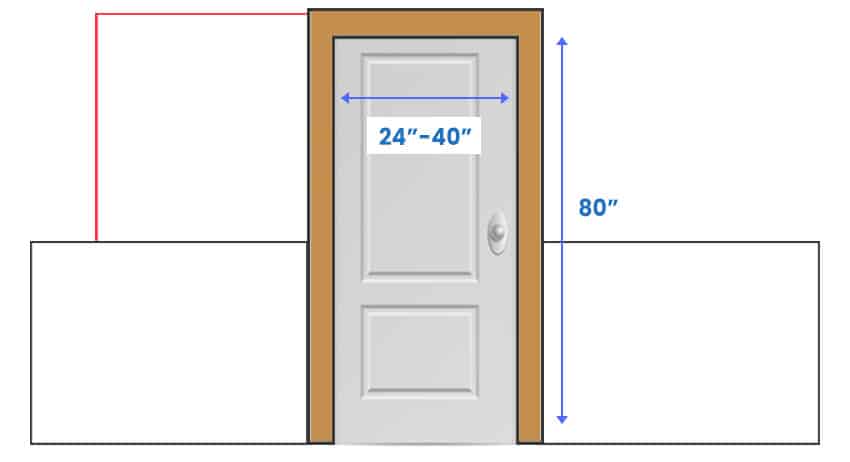
Pocket door systems can be 51 to 162 inches wide and 86 inches in height or higher.
A single-pocket door panel is often 24 inches to 40 inches wide and 80 inches tall, but double-pocket door panels are typically 86 inches tall and provide a clearance of 82 inches.
A 24-inch panel is often the smallest standard-sized pocket door available. A rough aperture of 49.75 inches would be required. The panel’s height is normal at 80 inches, and it fits a rough aperture of 84.5 inches.
A pocket door rough aperture is the whole space required between the studs to construct the enclosed sliding system. Normally, the general guideline is to double the panel size by two.
Afterward, depending on the door size, you can add 1 to 1.75 inches. Add 2.25 inches for height, bringing the rough aperture for an 82.25-inch system to 84.5 inches.
A rough aperture for a 30-inch pocket door, for instance, would be 61 inches in width. A 36-inch door would have a rough aperture of 73.75 inches wide.
You should verify the manufacturer’s precise specifications before constructing your wall for sliding panels. Read more in our pocket door size guide here.
Can A Pocket Slider In The Bathroom Lock?
Yes, you can secure the bathroom inside your home by locking the sliding mechanism in the recessed pull. They can be locked on either one or both sides. You can also secure your bathroom slider by using a lock with a key. The locks can be either circular or square.
Do These Doors Block Sound?
No, pocket doors do not provide much sound insulation. These panels are not very soundproof, whether you decided to pick them or they were installed when you purchased the house.
One of the reasons is they might not sit or seal as snugly as standard doors. As a result, they may not effectively prohibit noise from spreading from one room to another.
Pocket doors open and close by rolling on a track. No matter how delicately you push the door, it will make little noise as it slides. Visit our guide on how to soundproof a door for more tips.
Pocket Vs. Barn Door for Bathroom
In Terms of Appearance – Pocket doors are a unique addition to many houses since they drop into the wall, concealing the door when it is open. Because the door is intended to be closed out of visibility, this might be a very simple design. They, nonetheless, are available in a variety of styles ranging from classic to modern. They are also available in a variety of materials that improve the aesthetics of the space.
On the other hand, barn doors generally have a more unique appearance. These wood doors typically have a more rustic polish and appearance. They are suitable for a wide range of home designs such as country, earthy modern, farmhouse, and cottage. They can work in modern or futuristic interior designs when created with a solid panel or installed with glass panes.
In Terms of Overall Usage – Pocket doors and barn doors are both designed to save space. Because they do not open out inward or outward the room, they are ideal for bathrooms and other spaces that require greater mobility and accessibility.
Pocket doors, on the other hand, slide into the wall and are hidden while open. When open, barn sliders glide on a track on the outside of a wall and conceal it. Because panels slide between rooms and corridors, they are slightly more adaptable.
When open, barn doors might block plugs and wall controls, so they must be able to move across a blank wall. Thus, no artwork or shelving can be placed. Since pocket doors are installed within the wall, the exterior wall can be left blank.
In Terms of Installation – Pocket doors are more complex and time-consuming to install for a renovation since they are mounted on a track that is both within the doorway and inside the neighboring wall. In some circumstances, the track must be installed through an opening in the wall.
Barn doors, however, are installed across the doorway as well as along the outside of the neighboring wall. This ends up making them considerably simpler to install as the track can be visible at all times, eliminating the need to open the wall or refinish it once the track is installed. The track can be put on any wall, regardless of how thin or load-bearing it is.
In Terms of Maintenance – These two types of doors both need basic maintenance. Since they all glide down a track, it should be kept clean and free of fragments that might end up causing the wheels or rollers to fail from functioning. They may also need to be oiled or rehung regularly if the track malfunctions.
This maintenance is typically simpler to perform on a barn slider than on a pocket slider since it is totally exposed and conveniently accessible. At least half of the track for the slider is hidden in the wall, making maintenance more complex.
In Terms of Durability – Both designs employ a track, which can potentially induce durability issues. It all boils down to the track’s strength and the materials used to make it. Both doors may slip off their tracks, become awkward to roll, screech or squeal if not greased, and gap or hang, making sealing and locking difficult.
Nonetheless, because the panel is exposed, barn doors frequently have a bigger track. This indicates that the track may have fewer problems in the long run than the compact pocket track. Barn doors are easier to repair when difficulties arise. Therefore, serious issues are less prevalent with barn-style sliders.
In Terms of Noise – In principle, pocket and sliding barn doors are not intended to provide sound insulation. It is conceivable to lessen noise by adding acoustic paneling to the panels themselves, although this can make them bulkier and more prone to slipping off their tracks.
Visit our alternative to pocket doors for more related content.

